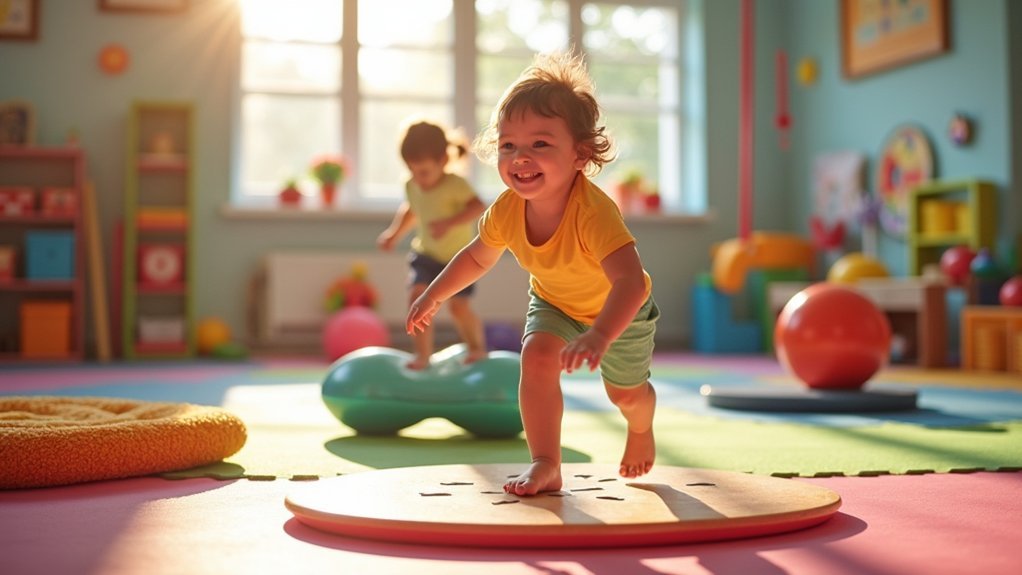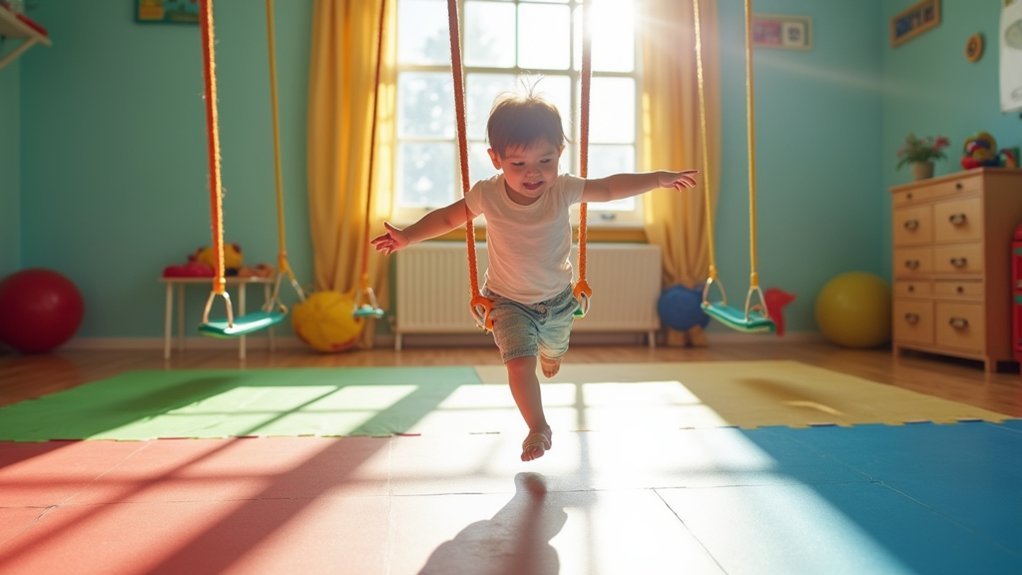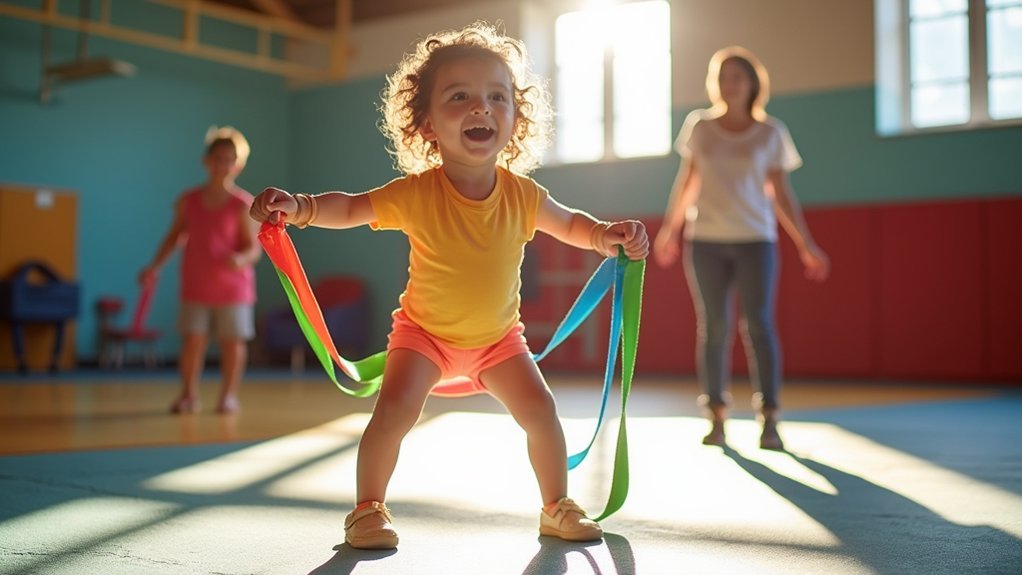Special needs movement tools enhance body awareness by providing targeted proprioceptive and vestibular input that helps children understand their body position in space. You’ll see improvements in coordination, muscle strength, and spatial awareness as they engage with equipment like weighted resources, balance boards, and climbing structures. These tools create safe opportunities for sensory exploration while building confidence through resistance activities and therapeutic play. Discover how these specialized environments can transform a child’s relationship with their physical self.
The Connection Between Movement and Proprioceptive Development

When children engage with specialized movement tools, they’re developing much more than just physical strength—they’re building their proprioceptive sense. This internal awareness system helps them understand where their body is in space without having to look.
As your child climbs, jumps, or navigates obstacle courses, they’re receiving essential proprioceptive input that reinforces body awareness. These sensory experiences create a foundation for automatic body adjustments during everyday tasks.
You’ll notice improved coordination as their brain better integrates this sensory information.
Activities requiring resistance or heavy work—like pushing weighted objects or using compression equipment—are particularly effective. They provide the deep pressure feedback that many children with special needs crave, helping reduce anxiety and clumsiness while improving focus in learning environments.
Specialized Equipment That Supports Body Schema Recognition
Building on the proprioceptive foundation we’ve explored, specialized equipment offers powerful tools for enhancing your child’s body schema recognition.
These carefully designed resources create opportunities for your child to develop stronger awareness of their body’s position in space through active engagement and sensory experiences.
Active engagement through sensory-rich experiences helps children map their physical presence in the world around them.
- Climbing structures provide essential proprioceptive input as children navigate different heights and positions.
- Zip lines allow children to experience dynamic movement, reinforcing spatial awareness.
- Sensory play equipment engages multiple senses while promoting social interaction.
- Weighted resources, used under professional guidance, help define body boundaries.
- Movement-oriented tools encourage motor planning, challenging your child to recognize their physical capabilities.
When you incorporate these specialized tools into your child’s routine, you’re supporting their body schema development through meaningful, engaging activities that make movement exploration both purposeful and enjoyable.
How Vestibular Stimulation Enhances Spatial Awareness

Engaging in movement challenges that stimulate your vestibular system can greatly improve your child’s proprioceptive sense and spatial orientation.
You’ll notice enhanced body awareness as your child interacts with therapeutic swings, balance boards, and spinning equipment.
These specialized tools create opportunities for controlled vestibular input that strengthens neural connections between movement sensation and spatial understanding.
Movement Challenges Proprioception
The profound connection between vestibular stimulation and spatial awareness forms the foundation of proprioceptive development in children with special needs.
When your child struggles with movement challenges, their body awareness often suffers, making proprioceptive input essential for developing coordination and spatial orientation.
- Balance boards help your child’s brain interpret their body’s position in space
- Spinning activities enhance vestibular processing, reducing spatial confusion
- Traversing uneven surfaces strengthens proprioceptive feedback pathways
- Therapy swings provide controlled vestibular input for children with sensory sensitivities
- Regular movement activities decrease anxiety when facing new spatial challenges
You’ll notice significant improvements in your child’s ability to judge distances and traverse environments as you incorporate these specialized tools into their daily routine, reinforcing their body awareness through targeted vestibular stimulation.
Therapeutic Equipment Benefits
Specialized therapeutic equipment transforms vestibular development beyond basic awareness into thorough spatial mastery.
When your child uses swings or zip lines, they’re receiving essential vestibular stimulation that activates their inner ear systems, improving their understanding of where their body exists in space.
You’ll notice significant improvements as they engage with these tools regularly. Children who receive proper vestibular and proprioceptive input show enhanced confidence maneuvering their environments. They’re less fearful of movement challenges and develop stronger gross motor skills.
Equipment that combines movement with strategic proprioceptive input helps your child’s brain process spatial information more effectively.
This consistent vestibular stimulation leads to better self-regulation and reduced anxiety around spatial challenges—ultimately creating a foundation for improved body awareness and environmental interaction.
Creating Safe Spaces for Sensory Exploration and Movement
Creating safe spaces where children with special needs can freely explore sensory experiences represents a cornerstone of effective movement therapy.
These environments allow your child to receive essential sensory input and proprioceptive feedback in a controlled setting. You’ll notice improvements in their coordination and spatial awareness as they engage with specialized equipment like crash pits that encourage both movement confidence and self-regulation.
- Climbing structures and zip lines promote active play while enhancing body awareness
- Safe landing areas encourage risk-taking while providing calming deep pressure stimulation
- Dedicated sensory spaces support physical, emotional, and social development
- Inclusive environments foster cooperative play among children of all abilities
- Specialized equipment helps children with sensory processing challenges develop critical spatial awareness skills
The Role of Resistance-Based Tools in Building Body Confidence

Resistance-based tools offer your child vital proprioceptive input that helps them understand where their body exists in space.
You’ll notice improved joint stability as these tools encourage muscle engagement around major joints, creating a foundation for confident movement.
These tools also enhance your child’s bilateral coordination skills, allowing them to use both sides of their body together—a skill that’s essential for everyday activities from tying shoes to climbing playground equipment.
Resistance for Proprioceptive Input
When children struggle with body awareness, resistance-based tools can transform their sensory experience by providing essential proprioceptive feedback.
You’ll notice improved self-regulation as your child pushes, pulls, and works against resistance, helping them better understand where their body exists in space.
- Therapy bands create tension that signals joint position, enhancing proprioceptive input
- Weighted vests provide constant feedback about body boundaries during movement
- Resistance activities improve motor planning by requiring intentional muscle engagement
- Push-pull games develop coordination while building body awareness through playful interaction
- Daily resistance work can reduce anxiety by meeting sensory needs that support self-regulation
Creating Joint Stability
Joint stability forms the foundation of movement confidence for children with special needs.
When you introduce resistance-based tools like therapy bands and weighted vests into their activities, you’re providing essential proprioceptive input that engages supporting muscles. These tools work by challenging the body to maintain alignment during movement, naturally strengthening the muscles that protect and stabilize joints.
As your child uses resistance equipment regularly, they’ll develop improved core strength, which directly enhances balance and coordination during everyday tasks.
This physical stability translates into cognitive benefits too—they’ll gain better awareness of their body’s position in space and develop automatic postural adjustments essential for complex movements.
You’ll notice their growing confidence as joint stability improves, encouraging them to attempt new physical challenges with greater self-assurance.
Building Bilateral Coordination
Bilateral coordination emerges as a critical skill for children with special needs, particularly when strengthened through purposeful resistance work. When you introduce resistance bands and weighted resources into your child’s routine, you’re helping them develop symmetrical movement patterns that require both sides of their body to work together.
Resistance tools provide valuable proprioceptive input, enhancing your child’s awareness of body position and movement.
Regular bilateral coordination exercises build muscle strength essential for everyday functional tasks.
As children overcome resistance challenges, they gain confidence in their physical abilities.
Resistance-based play encourages active engagement, strengthening the mind-body connection.
These tools create opportunities for children to experience success through physical milestones, reinforcing their body awareness.
Tactile Equipment That Strengthens Body Boundary Understanding
Understanding where your body begins and ends in space represents a fundamental skill that many children with special needs struggle to develop naturally. Tactile equipment offers powerful solutions through varied sensory feedback that helps define these boundaries.
When your child interacts with textured mats and sensory balls, they’re receiving essential proprioceptive input that improves their spatial orientation.
You’ll notice improvements in fine motor skills and hand-eye coordination as they explore different body positions using these tools. Equipment with varying textures and weights teaches them to regulate movement intensity and find appropriate body positioning.
This tactile exploration creates meaningful connections between physical sensations and emotional responses, enhancing self-regulation abilities. By incorporating these sensory-rich tools into daily routines, you’re building your child’s body awareness foundation.
Movement Progressions: From Supported to Independent Body Control
You’ll see remarkable progress when you introduce movement tools that provide guided input through supported positioning and stabilizing equipment.
As your child grows more confident, you can gradually reduce physical support while maintaining the sensory feedback that helps them understand their body’s position in space.
This scaffolding approach builds neurological pathways for movement patterns that eventually become automatic, allowing your child to shift from supported activities to independent body control at their own pace.
Guided Input, Growing Independence
The journey toward independent body control begins with carefully guided movement experiences that provide essential sensory feedback.
When your child uses adaptive equipment, they’re receiving structured proprioceptive input that builds body awareness while their nervous system processes these sensations into meaningful information.
- Start with highly supported tools that offer maximum guidance
- Gradually reduce physical supports as confidence develops
- Introduce activities requiring increasing motor planning complexity
- Celebrate small successes that build self-regulation skills
- Shift to equipment that promotes more independent movement
As your child progresses through these movement experiences, their brain’s neuroplasticity enables them to develop more sophisticated body control.
You’ll notice them applying these skills to daily activities, showing how guided movement experiences translate into growing independence and functional capabilities.
Scaffolding Sensory Movement Patterns
Scaffolding children’s movement experiences creates a purposeful pathway toward independent body control. When you introduce supported tools like therapy swings and harnesses, you’re providing essential proprioceptive input that builds foundational movement patterns before children attempt unassisted activities.
You’ll notice progress as your child shifts from fully-supported to partially-supported movements, developing body awareness and confidence along the way. Equipment like climbing structures and crash pits offer safe environments to explore varied movement patterns and integrate sensory feedback with motor planning.
This systematic approach especially benefits children with conditions like cerebral palsy, as specialized equipment addresses specific coordination challenges.
The ongoing engagement with these tools promotes neuroplasticity—strengthening neural connections that transform supported experiences into independent body control, creating lasting pathways for movement development.
Multi-Sensory Equipment for Comprehensive Body Awareness
Multi-sensory equipment serves as a cornerstone for developing extensive body awareness in children with special needs.
Specialized sensory tools establish the foundation for comprehensive bodily understanding in exceptional children.
When you incorporate climbing structures, zip lines, and crash pits into therapy sessions, you’re engaging multiple muscle groups while providing essential deep pressure stimulation that promotes self-regulation.
Weighted resources enhance proprioceptive input, helping children understand their body position without visual feedback.
- Climbing structures and zip lines activate diverse muscle groups for improved motor planning
- Crash pits deliver calming deep pressure stimulation supporting self-regulation
- Weighted tools enhance proprioceptive awareness during movement activities
- Multi-sensory equipment naturally encourages social interaction and cooperative play
- Specialized sensory play equipment allows for customized activities that address individual sensory processing needs
This all-encompassing approach guarantees children develop full-body awareness while experiencing the emotional benefits of supportive, engaging environments.
Incorporating Therapeutic Goals Into Play-Based Movement Activities
Seamlessly weaving therapeutic goals into playful movement activities creates powerful learning opportunities for children with special needs. When you integrate weighted vests or resistance bands during playtime, you’re enhancing proprioceptive input while children engage naturally with their environment.
Consider setting up obstacle courses or tug-of-war games that target specific therapeutic objectives while simultaneously boosting your child’s body awareness. These structured activities help children understand their physical capabilities and position in space.
Climbing structures and crash pits serve dual purposes—they encourage physical development while fostering essential social skills through cooperative play.
Customizable Equipment for Individual Sensory Processing Needs
When selecting equipment for children with diverse sensory processing needs, personalization becomes the cornerstone of effective intervention. Customizable equipment enables therapists to create targeted sensory experiences that directly enhance body awareness through personalized resistance, movement patterns, and sensory feedback.
- Adjustable swings and climbing structures provide varying levels of proprioceptive input, helping children develop stronger awareness of their body’s position.
- Weighted resources can be modified to match each child’s specific requirements for tactile feedback.
- Balance boards with adjustable difficulty settings allow gradual skill development in coordination.
- Sensory tunnels of different sizes create proprioceptive challenges that improve spatial awareness.
- Crash pits with customizable depths offer safe environments for children to explore movement boundaries.
The Impact of Consistent Movement Opportunities on Long-Term Body Awareness
Consistent exposure to therapeutic movement activities fundamentally reshapes how children with special needs develop body awareness over time.
When you provide regular opportunities for movement, you’re supporting neuroplasticity—allowing their brains to form stronger connections related to spatial orientation and body positioning.
Daily proprioceptive input through weighted resources and climbing structures delivers varied sensory experiences that help children process and integrate information about their bodies.
Consistent proprioceptive input transforms how special needs children interpret their physical presence in the world around them.
You’ll notice improvements in their coordination and motor planning as their brains learn to interpret proprioceptive feedback more accurately.
Early intervention with consistent movement opportunities can prevent sensory processing difficulties from developing.
Children who regularly engage with movement tools navigate their environments with greater confidence and reduced anxiety, establishing a foundation for lifelong body awareness that supports independence in daily activities.
Measuring Progress: Observable Improvements in Body Awareness Through Equipment Use
Identifying progress in body awareness requires more than casual observation.
You’ll need specific metrics to track how movement tools enhance your child’s proprioceptive input and spatial recognition. When children regularly engage with specialized equipment, you can document measurable improvements in their physical capabilities and emotional regulation.
- Increased ability to navigate climbing structures safely demonstrates improved spatial awareness
- Enhanced bilateral coordination observed during activities requiring cross-body movements
- Reduced anxiety and better focus after using weighted resources for proprioceptive input
- Greater confidence in attempting new physical challenges, indicating improved motor planning
- Measurable progress in age-appropriate activities, from simple balance tasks to complex obstacle courses
These concrete indicators help you track how specialized movement tools directly contribute to your child’s developing body awareness and self-regulation skills.
Frequently Asked Questions
What Is the Body Awareness in Movement Concept?
Body awareness in movement is your ability to sense your body’s position, how parts relate to each other, and your spatial orientation. It’s essential for coordinating movements effectively without visual cues.
How to Improve Body Awareness in Autism?
You’ll improve body awareness in autism by providing proprioceptive input through resistance activities, deep pressure exercises, and sensory play. Label physical sensations during movement and encourage self-reflection to help children understand their bodies better.
What Activities Improve Body Awareness in Occupational Therapy?
You’ll improve body awareness in occupational therapy through proprioceptive activities like heavy lifting, resistance exercises, deep pressure techniques, movement tasks (ball bouncing, climbing), and fidget tools that provide sensory feedback about your body’s position.
Is Body Awareness a Sensory Issue?
Yes, body awareness is often connected to sensory processing. Your brain interprets proprioceptive input to understand where your body is in space. When this system isn’t working properly, you’ll experience sensory issues.
In Summary
You’ve seen how special needs movement tools work with your child’s developing sensory systems. They’re not just fun—they’re therapeutic investments that strengthen proprioception, vestibular processing, and spatial awareness. By providing regular opportunities with customized equipment, you’ll notice improvements in your child’s confidence and body awareness. Remember, consistent access to these tools doesn’t just support development today—it builds a foundation for more independent movement tomorrow.





Leave a Reply